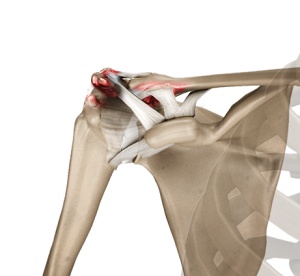
What is AC or Acromioclavicular Arthritis?
The acromioclavicular joint is part of the shoulder joint. It is formed by the union of the acromion, a bony process of the shoulder blade, and the outer end of the collar bone or clavicle. The joint is lined by cartilage that gradually wears with age as well as with repeated overhead or shoulder level activities such as basketball. The condition is referred to as AC arthritis or acromioclavicular arthritis.
What Causes AC Arthritis?
AC arthritis is caused by the wearing out of the cartilage covering the bone ends in a joint. This may be due to excessive strain over prolonged periods of time, or due to other joint diseases, injury or deformity. AC arthritis may also be the consequence of another disease or condition, such as shoulder separation.
What are the Symptoms of AC Arthritis?
Symptoms generally include pain or tenderness in the joint that occurs at the top and front of the shoulder where the clavicle and scapula meet, pain with certain motions, swelling, and stiffness due to a limitation of motion of a joint or inactivity.
How is AC Arthritis Diagnosed?
When you present with the above symptoms, your doctor will review your medical history and perform a physical examination. An injection into the joint can temporarily reduce pain while identifying the AC joint as the source of pain. Other tests your doctor may order include X-rays, MRI scans which may reveal cartilage destruction and abnormal fluid accumulation within the joint, and bone scan or ultrasound of the joint.
How is AC Arthritis Treated?
Your doctor will treat your symptoms non-operatively by instructing you to limit or modify your activities and controlling your pain. Pain is controlled by pain medication, anti-inflammatory medication, corticosteroid injections into the joint, and physical therapy. If symptoms persist, surgery may be recommended. Surgery may be performed by a minimally invasive technique using arthroscopy or a traditional open method. It usually involves removal of less than one centimeter of bone from the end of the collarbone (distal clavicle resection) to prevent the bones in the joint from rubbing against each other.
Related Topics
- Frozen Shoulder
- Shoulder Instability
- Arthritis of the Shoulder
- Acromioclavicular (AC) Arthritis
- Rotator Cuff Tear
- Shoulder Pain
- Anterior Shoulder Instability
- Posterior Shoulder Instability
- SLAP Tears
- Shoulder Labral Tear
- Shoulder Fracture
- Clavicle Fracture
- Glenoid Fractures
- Proximal Humerus Fractures
- Shoulder Trauma
- Rotator Cuff Pain
- Shoulder Disorders
- Subacromial Impingement Syndrome
- Overhead Athlete's Shoulder
- Shoulder Impingement
- Shoulder Dislocation
- Little League Shoulder
- Proximal Biceps Tendon Rupture
- Shoulder Labral Tear with Instability
- Baseball and Shoulder Injuries
- Acromioclavicular (AC) Joint Osteoarthritis
- Proximal Biceps Tendinitis
- AC Joint Separation
- Shoulder Tendonitis
- Throwing Injuries of the Shoulder
- Internal Impingement of the Shoulder
- Rotator Cuff Re-tear
- Rotator Cuff Calcification
- Partial Rotator Cuff Tear
- Bicep Tendon Rupture
- Calcification Tendinitis
- Periprosthetic Shoulder Fracture
- Long Head Biceps Tendon Rupture
- Multidirectional Instability of the Shoulder








